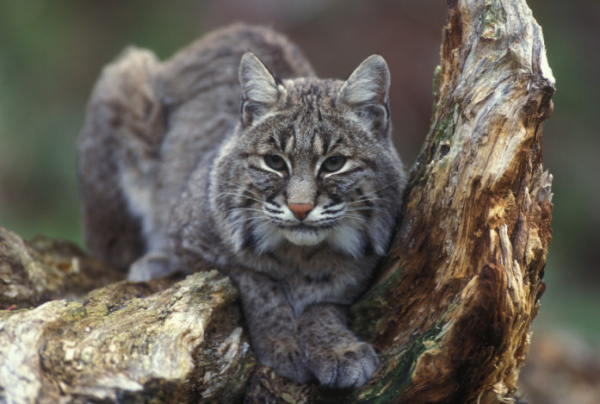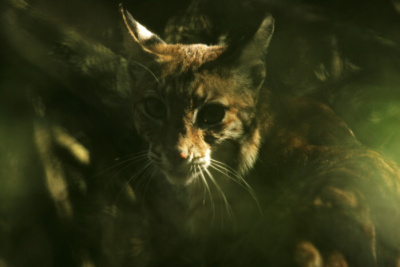BOBCAT IN TREE — PHOTO BY GARY KRAMER, USFS
When she arrived in Los Angeles from Texas more than five years ago, Laurel Klein didn’t know that much about bobcats – what she really wanted to study was the large and lanky mountain lion, the iconic image of a big cat predator. But her internship with the National Park Service put her to work tracking, observing and studying bobcats, those seldom-seen urban carnivores that dot the Southern California landscape.
Now years later with countless hours in the field and in the laboratory, the biologist has learned how to think more like a bobcat. “When I go out hiking, things are different for me from before,” says Klein. “I see animal signs in the field – deer scat, tracks – but I always notice if I am in a bobcat area. I see scrapes and can even smell the urine of a bobcat. I’m definitely more in tune with the environment when I’m out there.”
On August 16 at 7:30 p.m. at Temsecal Gateway Park in Pacific Palisades, Klein will share stories about her life with bobcats as well as her research on how urban development affects bobcat’s disease susceptibility and how humans can boost the bobcat’s survival.
Klein will also be presenting a similar talk on August 27 at the Ribbit Tree and Plant Nursery in Topanga Canyon.
Dispelling the myths about bobcats is part of the reason Klein reaches out to the public in lecture and on her website, Urban Carnivores. First and foremost, she says, people are “surprised to learn that there are so many of them here and are live very close by. They just don’t think bobcats are around, especially in places like Griffith Park. But they are.”
Living in extremely fragmented areas, such as the 6 sq. mile of protected habitat in Griffith Park, bobcats have small home ranges and they can persist in urban areas, says Klein. Through her research – in collaboration with the USGS – she’s captured, collared and tracked bobcats also in Bel Air, Beverly Hills and Hollywood Hills, Topanga, Thousand Oaks and in a patch of land between the 405 and 101 Freeways.
Klein and researchers have studied these bobcats’ movement patterns, learned how much time they spent in urban areas versus wilderness and discovered how long they stayed in certain areas. (Radio collars are triggered to fall off after a certain time period so cats don’t need to be re-trapped to remove collars.)
The research provided a “connect the dots” overview of the life and times of urban bobcats, says Klein.
“We’ve created these pockets of habitats for them,” she explains about the creation of freeways, shopping malls and master-planned communities which fragment bobcats into smaller communities. “Bobcats are in these areas and we are lucky to have them.”
Indeed, with the latest science news about the role of top or “apex” predators as vital to having a healthy ecosystem, the bobcat’s role is even more desirable here in the natural world of Southern California.
Tracing its ancestry back to lynxes, bobcats are found in every state of the lower United States and parts of Mexico. With its signature short-tailed and ear turfs, the bobcat has been called the master of adaptability for its amazing ability to blend and survive in various climates, environments and alongside highly dense urban areas with relatively little ease.
But Klein is quick to reassure homeowners that there’s little chance of a bobcat stealing into people’s backyards in search of a kitty or small dog snack. They prefer hunting under the veil of darkness and out of the way of humans. If you do happen to catch a glimpse of a bobcat on your property or on an evening hike, you are very fortunate indeed, says Klein. (From Klein’s website, click here for a peek into the life of a local mama bobcat and her kittens — amazing!)
Because of their small compact body size, (bobcats average between 15-35 pounds and stand about 2 feet tall) they catch and eat small animals whereas the larger mountain lion needs to go after deer and other big animals. Usually on the bobcat’s menu here in SoCal are rabbits, ground squirrels, gopher and wood rats. (That’s not to say bobcats won’t take down a young or old deer – the effort to take down a deer is a deterrent when an easy pounce at a mouse will get you more mouthfuls for the bang.)
A diet in wood rats, however, is troubling for bobcats, notes Klein which brings her to the second reason for talking to the public: weaning us humans off toxic rat poison that is making its way into the bobcat’s stomach and blood streams.
“[Bobcat prey] is the same animals that people target with rat poison,” she says having seen the effects of these anticoagulant rodenticides on bobcats and mountain lions. Area biologists report that nearly 80 percent of all mountain lions are secondarily poisoned by anticoagulants. She’s been asked if there are “safe” poisons or safe levels to use of these common poisons. Her answer is simply, “there is no safe level,” adding that these chemicals reside in the liver of an animal for months and even a year.
Of course, it’s not just bobcats that are affected by rat poison. Owls, condors, foxes, weasels, any predator animal that finds rats and mice tasty are being exposed to these toxic chemicals.
“The easiest thing for people to do on an individual level to help wildlife like bobcats is to stop using rat poison,” she says.
While she spent many hours in the field, these days Klein is in the lab, piecing data together about the connection between anticoagulant exposure and mange, an often fatal disease bobcats get from mites burrowing under the skin. On Klein’s website, photos of hairless bobcats dying from mange is sobering – and enough to make the most livid of rat-haters give up the poison for good.
Klein offers alternatives for people who want to rid their backyards of small pests: encourage natural predators – such as owls – to view your area as a buffet line. Nesting boxes and owl perches are easy additions (see http://www.hungryowl.org/ for more information on how to make and install).
As always, prevention is more than half the battle. Rodent proof your home, take out trash and keep vegetation cut so you’re not providing a cover for small critters. Remove bird feeders and bird baths. If the critters still persists, mechanical traps, like those wooden snap traps you see in every Looney Tunes cartoon, are easy, cheap and effective.
Overall, Klein moves ever forward in her quest to learn more about the nature of bobcats. She remembers the 18 months she spent setting and checking traps twice daily out in the wild. “I think I caught as many foxes as empty cages!” she says with a laugh. But she relished every successful catch because it meant more opportunities.
From handling a sedated animal in a trap, to watching bobcat movements via radio signals, to researching blood samples and talking to the public about these amazing carnivores, “It’s been a very remarkable experience,” she says. “There is still much more to learn.”
— Brenda Rees


